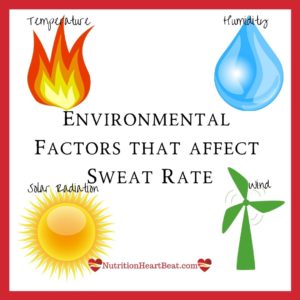Plan your hydration around these variables for a better race, match, meet or training session.
The goal of sweating is to get water to evaporate from your skin, causing cooling. There are four environmental factors that influence your sweat rate: temperature, humidity, solar radiation and wind. Learn how they impact your hydration needs and drinking plans for races and competitions.
Hydration Factor 1: Temperature
The hotter it is, the more you’ll sweat. The cooler it is, the less you’ll sweat, although how well you dress to exercise in cold weather also has an impact. There should be an annual cycle where you don’t sweat much in the winter, sweat rates increase through the hot summer days and then drop off again into the fall and winter.
Hydration Factor 2: Humidity
Much like temperature, the more humid it is, the more you’ll sweat. The drier it is, the less sweat you’ll notice. In humid conditions, sweat doesn’t always evaporate. Sometimes it drops down the body, dripping onto the ground or soaking into your clothes. Because water didn’t evaporate in this process, this is called non-productive sweating.
In dry conditions, you’ll need to release heat, but the water evaporates so quickly that you never feel wet or sweaty. This is fine, except for those who need the cues of wet clothes or sweat to remember to drink.
Hydration Factor 3: Solar Radiation
Solar radiation is the sunlight hitting you directly while exercising. The more you have, the warmer you feel and the more (assuming it’s not freezing out) you sweat. Were you to measure it, you would combine data on the sun angle and cloud cover.
This solar radiation comes partly from direct sun and partly from the environment you’re exercising in. In natural environments with a lot of vegetation or landscaping (grass, trees, bushes, flowers), those plants will absorb the radiation. That means less radiation and heat for you. In natural environments without vegetation, such as sand, snow, water or rock, and in built environments with reflective surfaces (pavement, glass, steel, paint or artificial turf) the solar radiation that hits those environments can reflect back onto you. This means that you’re getting extra radiation and feeling warmer.
Hydration Factor 4: Wind
Wind works differently than the first three factors. The windier it is, the more heat is lost through convection. The more calm it is, the less heat is lost. Like solar radiation, wind can change from minute to minute, so it is difficult to predict the effects of wind beyond generalizations.

Wet bulb globe temperature
Collectively, these four factors – measured in the sun – make up the Wet Bulb Globe Temperature. It’s possible to buy small handheld machines that measure these factors, but it’s not really worth knowing the WBGT from minute to minute. Temperature and humidity change across the day, while wind and solar radiation can change from minute to minute. Most people look at Heat Index, which is a combination of humidity and temperature and measured in the shade.
Here is a chart of temperature and humidity that approximates the Wet Bulb Globe Temperature.
How to adjust your hydration
- Do some sweat tests.
- Drink more as it gets hotter and more humid, less as it cools off and becomes less humid.
- Think about your environment and check the weather forecast before heading out the door. Running on pavement in a city this weekend for a humid early morning 5K? You might need a little more to drink than you think. Have a late afternoon practice on artificial turf on an otherwise cool, dry and windy day? You might need to drink less.
Need more information? How about this infographic on doing a sweat test? Or these options for learning more about your hydration? Reach out here for a free Discovery Call! If you know you need more hydration but don’t enjoy the standard sports drinks, try these non-sweet options. If you think your menstrual cycle impacts your hydration status and fluid needs, you’re right!
